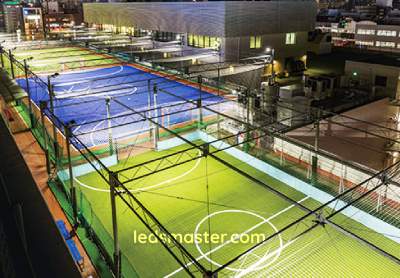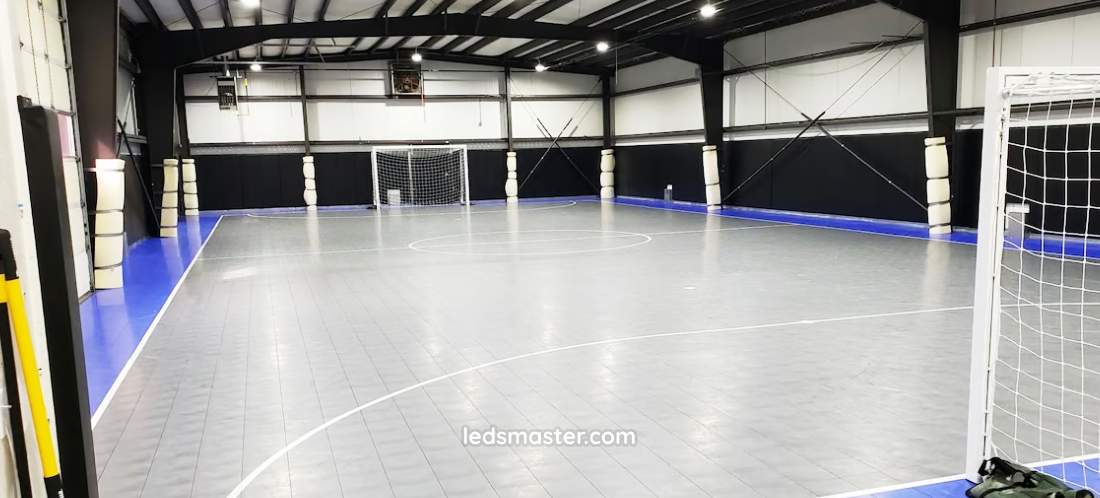Whether for professional matches or recreational play, the right lighting ensures clear visibility, enhances the playing experience, and creates a welcoming environment for spectators. This article explores the key considerations in designing and implementing optimal lighting solutions for futsal fields.
Our LED futsal court lighting provides high-quality illumination for both football players and spectators. Our flood lighting system for five-a-side football pitches is suitable for both outdoor and indoor installations, thanks to its watertight design that withstands adverse weather conditions. Additionally, the exclusive heat sink effectively dissipates heat, preventing accumulation when the lights are mounted on indoor soccer field ceilings.
Switching from metal halide, halogen, and mercury vapor lights to LED lighting significantly reduces electricity consumption and maintenance frequency. Our LED futsal field lights boast a lifespan of over 120,000 hours and an energy efficiency of 170 lm/W, which is approximately 10 times greater than that of halogen bulbs.
Futsal is similar to conventional soccer, with the primary difference being that each side consists of only five players, including four players and one goalkeeper. Let’s explore how to illuminate a futsal soccer astroturf with LED lights.
Get your complimentary lighting design today
Table of Contents
Toggle The brightness requirement of floodlights for a five-a-side soccer pitch varies based on the intended use of the field. For fields designed to host televised competitions, the lux level required is significantly higher. Professional matches, such as those governed by FIFA, require approximately 800 to 1200 lux to ensure that the action is clearly visible on screen and that there are no dark spots or shadows that could interfere with gameplay or broadcasting quality. This level of brightness enhances the viewing experience for spectators and ensures that players can perform at their best under optimal lighting conditions.
The brightness requirement of floodlights for a five-a-side soccer pitch varies based on the intended use of the field. For fields designed to host televised competitions, the lux level required is significantly higher. Professional matches, such as those governed by FIFA, require approximately 800 to 1200 lux to ensure that the action is clearly visible on screen and that there are no dark spots or shadows that could interfere with gameplay or broadcasting quality. This level of brightness enhances the viewing experience for spectators and ensures that players can perform at their best under optimal lighting conditions.
In contrast, fields intended for recreational play or training purposes need considerably less intense lighting. A lux level of about 300 to 400 lux is generally sufficient for these applications. This lower level of brightness still provides adequate visibility for players to see the ball and each other, ensuring a safe and enjoyable playing experience. However, it is less demanding in terms of energy consumption and equipment, making it a more economical option for facilities that do not need to meet the stringent requirements of professional competitions.
To adequately illuminate a 20 x 40 square meter indoor futsal court for training purposes, a detailed lighting calculation is necessary. For instance, to achieve the required 300 lux, the calculation would be as follows: (20 meters x 40 meters) x 300 lux = 240,000 lumens. This total lumens requirement translates to approximately 1500W to 2000W of LED lights, depending on the efficiency of the fixtures used. LED lights with higher efficiency can provide the same amount of lumens with lower wattage, thus saving energy and reducing operational costs.
For venues with high ceilings, additional power may be necessary to ensure sufficient illumination. High ceilings can cause light to spread out more before reaching the playing surface, potentially reducing the intensity of illumination. Therefore, using higher wattage lights or additional fixtures can help compensate for this effect, ensuring that the entire playing area is uniformly lit. Our free lighting design consultations can help you determine the best setup for your specific needs, taking into account factors such as ceiling height, the layout of the field, and the intended use of the space.

Proper orientation of the LED floodlights is crucial for achieving uniform illumination across the entire soccer field. Typically, there are multiple floodlights on each pole, each set at slightly different angles and directions. This arrangement ensures even light distribution, reducing shadows and glare that could interfere with gameplay. By carefully positioning the lights, we can ensure that the illumination is consistent across the field, enhancing visibility for all players regardless of their position.
Our lighting designers will work with you to determine the optimal orientation to achieve the best brightness and uniformity. This process involves detailed planning and precise calculations to account for the specific dimensions and layout of your field. Factors such as the height and spacing of the light poles, the angle of the lights, and the type of fixtures used all play a role in achieving the desired lighting outcome. By tailoring the lighting design to your unique needs, we can create an optimal environment for both players and spectators.

Replacing metal halide, mercury, or halogen floodlights with LED alternatives offers significant benefits. Traditional lighting options such as metal halide and halogen lamps are less efficient and have shorter lifespans compared to LED lights. They also tend to have longer warm-up times and can suffer from lumen depreciation over time, resulting in decreased brightness and uneven lighting.
In contrast, LED lights provide a substantial improvement in both brightness and uniformity. LED fixtures are designed to deliver consistent light output with minimal degradation over time, ensuring that the field remains well-lit for longer periods. They also offer better control over light distribution, allowing for more precise targeting and reduced light spill. This improved performance translates to better visibility for players, enhancing their ability to see the ball and each other clearly.
LED lights are more energy-efficient, consuming significantly less power while providing superior illumination. This energy efficiency results in lower operational costs and a reduced environmental impact. LEDs also have a longer lifespan, reducing the frequency of replacements and associated maintenance costs. This makes them a more economical and sustainable choice for futsal pitches.
Furthermore, LED lighting systems often come with advanced features such as dimming capabilities and programmable controls. These features allow for greater flexibility in managing the lighting environment, enabling you to adjust the brightness levels and create dynamic lighting effects as needed. This adaptability is particularly beneficial for multi-purpose facilities that host a variety of events and activities.
Accurate wattage calculations and optimal orientation of LED floodlights ensure uniform illumination. Switching from traditional HID lighting to LEDs offers better brightness, energy efficiency, and reduced maintenance costs. Thoughtful lighting design creates a high-quality environment for both professional and recreational futsal activities.